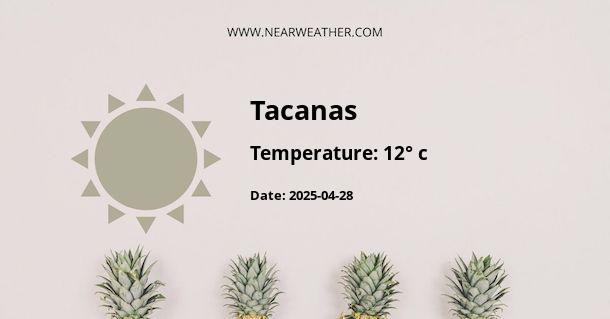Tacanas, AR Climate and Weather Overview
Tacanas, located in the northern region of Argentina, experiences a diverse climate with distinct seasonal variations. The local climate is influenced by various factors including its proximity to the Andes mountains, elevation, and its position within the southern hemisphere. Understanding the weather patterns and climate of Tacanas is essential for residents, tourists, and businesses operating in the area.
Annual Weather Summary for Tacanas, AR
The table below provides a comprehensive overview of the average weather conditions in Tacanas throughout the year:
| Month | Average High (°C) | Average Low (°C) | Precipitation (mm) |
|---|---|---|---|
| January | 30 | 18 | 150 |
| February | 29 | 17 | 140 |
| March | 27 | 16 | 120 |
| April | 24 | 13 | 80 |
| May | 21 | 10 | 40 |
| June | 18 | 7 | 30 |
| July | 18 | 7 | 30 |
| August | 20 | 8 | 30 |
| September | 23 | 10 | 40 |
| October | 26 | 13 | 80 |
| November | 28 | 15 | 120 |
| December | 29 | 17 | 140 |
As seen in the table above, Tacanas experiences warmer temperatures during the summer months of January and February with average highs around 29-30°C, while the winter months of June and July see cooler temperatures with average highs around 17-18°C. The region also experiences a distinct wet season from November to March, with precipitation levels reaching their peak in January at 150mm. The dry season from April to October sees significantly lower levels of rainfall, with the lowest precipitation occurring in June, July, and August at only 30mm.
Climate Classification
According to the Köppen climate classification, Tacanas falls under the category of a "dry-summer subtropical" climate. This classification indicates that the region experiences dry, hot summers and mild, wet winters. The proximity to the Andes mountains also influences the climate, creating microclimates within the region and contributing to variations in temperature and precipitation.
Extreme Weather Events
While Tacanas generally experiences moderate weather conditions, it is important to note that the region is susceptible to occasional extreme weather events. These can include heavy thunderstorms during the wet season, with localized flooding in low-lying areas. Additionally, the proximity to the Andes mountains can lead to sudden temperature changes and wind patterns, particularly in higher elevation areas.
Impact on Local Activities and Industries
The climate and weather patterns in Tacanas play a significant role in shaping local activities and industries. Agriculture, including the cultivation of grapes for winemaking, is influenced by the seasonal variations in rainfall and temperature. The tourism sector also sees fluctuations in visitor numbers based on weather conditions, with the summer months attracting outdoor enthusiasts and the winter months appealing to those seeking milder temperatures.
Conclusion
Understanding the climate and weather in Tacanas is essential for residents, businesses, and visitors to effectively plan and prepare for the seasonal variations in temperature and precipitation. By being aware of the distinct weather patterns and the influence of the Andes mountains, individuals and industries can adapt and thrive within the unique climatic conditions of this northern Argentinian region.
A - Tacanas's Latitude is -27.137520 & Longitude is -64.809288.
A - Weather in Tacanas is 12° today.
A - Climate Conditions in Tacanas shows clear sky today.
A - Humidity in Tacanas is 91% today.
A - Wind speed in Tacanas is 6.44 km/h, flowing at 339° wind direction. today.
